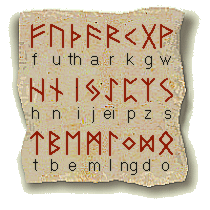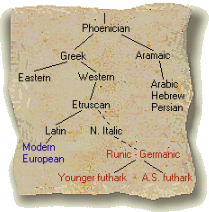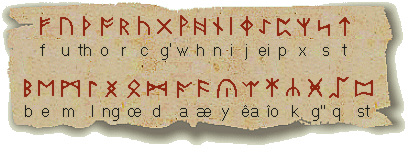 Fehu, F
Fehu, F
The rune of Freya and her brother Frey.
It stands for fee and gold.
Possessions, Nourishment, Cattle.
 Uruz, U
Uruz, U
This rune stands for strength and health.
It is associated with a horned animal called the aurochs.
Strenght, Manhood, Womanhood, The Wild Ox.
 Thurisaz, TH
Thurisaz, TH
The third rune is associated with giants (thurs).
Gateway, Place of Non-Action, The God Thor.
 Ansuz, A
Ansuz, A
Ansuz is associated with the Aesir, Odin, and the
wind.
Signals, Messenger Rune, The God Loki.
 Raido, R
Raido, R
This is the rune of journeying.
Journey, Communication, Union, Reunion.
 Kenaz,
Kenaz,
(Kano) K
Kenaz represents the torch.
Opening, Fire, Torch.
 Gebo, G
Gebo, G
Gebo stands for gift.
Partnership, A Gift.
 Wunjo, W
Wunjo, W
Wunjo is the rune
of joy and peace.
 Hagalaz, H
Hagalaz, H
This rune stands for hail.
Disruption, Elemental Power, Hail.
 Nauthiz, N
Nauthiz, N
Nauthiz stands for the strength of need.
Constraint, Necessity, Pain.
 Isa, I
Isa, I
Isa is the rune associated with ice.
Standstill, Withdrawal, Ice.
 Jera, Y
Jera, Y
The rune jera stands for year.
Harvest, Fertile Season, One Year.
 Eihwaz, EI
Eihwaz, EI
This rune is associated with the yew.
Defence, Avertive Powers, Yew Tree.
 Perth, P
Perth, P
Perth means fruit to some;
Initiation, Something Hidden, A secret Matter
 Algiz, Z
Algiz, Z
Algiz is a rune of protection or defense.
Protection, Sedge or Rushes, The Elk.

Sowilo, S
Sowilo is the rune associated with the sun.
Wholeness, Life Force, The Sun's Energy.

Tiwaz, T (Teiwaz)
Tiwaz stands for the war god Tyr.
This rune was carved on weapons to bring victory.
The Warrior, Tiw, the Sky God.

Berkano, B
Berkano stands for the birch goddess and is used for fertility
and birthing.
Growth, Rebirth, Birch Tree.

Ehwaz, E
This rune means horse.
Movement, Progress.

Mannaz, M
Mannaz stands for man. (The Self)

Laguz, L
Laguz is the rune associated with water.
Flow, Water, that which conducts.

Ingwaz, NG (inguz)
Ingwaz is the rune of the hero god Ing.
(Ingvenonen is the goddess, and all names like Inga, Inge derive from
it)
Fertility, New Beginnings,

Dagaz, D
Dagaz means day.
Breakthrough, Transformation.

Othila, O
Othila is the rune associated with inheritance.
Seperation, Retreat.

![]()




